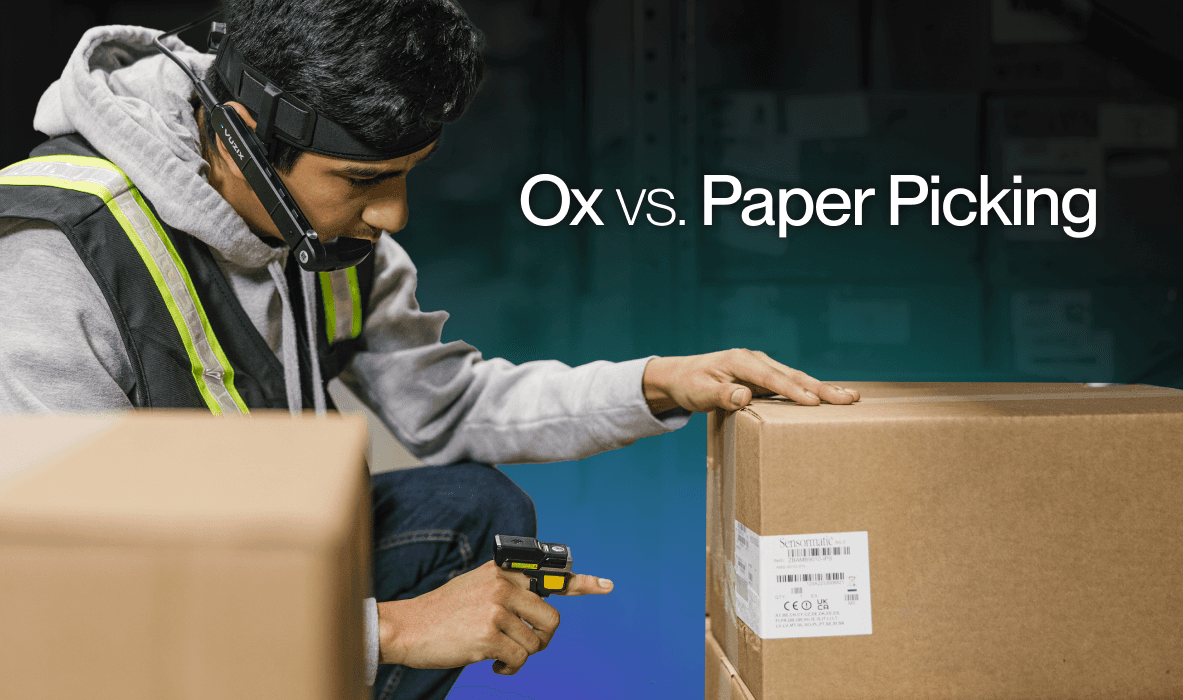June 13, 2023
Once upon a time, the term automation was synonymous with replacing humans. Move over, people, the machine is more efficient! Now, we’re entering a new era of automation: the human-centered era.
Human-centered automation is designed not to replace people, but to empower them. It works seamlessly in tandem with human workers, augmenting and complementing their skills, unlocking new levels of capability, and ultimately making their lives (and jobs) much easier. Human-centered automation is about as powerful as it gets. It’s the future of work — and, thanks to Ox’s pioneering technology, it’s the future of industrial operations.
Ox is the world’s first ever human-centered automation system designed to increase operational efficiency through AI, machine learning, and data.
Keep reading to learn how human-centered automation is revolutionizing supply chain operations.
Human-centered automation: What exactly is it and how is it different?
The First and Second Industrial Revolutions brought us powerful machines to carry out manual tasks. The Third Industrial Revolution gave us computers and digitalization. The Fourth Industrial Revolution is advancing this even further with artificial intelligence and the Internet of Things (IoT).
Now, we’re on the brink of a Fifth Industrial Revolution: Industry 5.0 — or, as we like to call it, the human-centered revolution.
So what’s Industry 5.0 all about?
Industry 5.0 is built on human-centricity and connectedness.
It’s no longer about humans and machines operating in separate spheres, or the individual capabilities of standalone technologies. This new era is about building an ultra-connected, super-smart infrastructure where people and technology collaborate seamlessly in tandem.
Human-centered automation is driving this revolution forward — enhancing humans rather than replacing them. The key principles of human-centered automation are:
User-friendly design: Technology is built for and around the people who’ll be using it, factoring in their needs, goals, and preferences throughout.
Collaboration and shared decision-making: Humans and machines work together in tandem to determine the best course of action, with the human worker having full and final control.
Empowerment and augmentation: The ultimate goal is to empower people to do their best, most efficient work. Technology serves to enhance and leverage human skills while filling in the gaps.
That’s human-centered automation in theory. So what does it look like in practice?
Real-world examples of human-centered automation
Many domains are now leveraging human-centered automation. Examples include:
Augmented Intelligence which uses technology to augment human intelligence: For example, virtual assistants (such as Amazon Alexa) that use natural language processing and machine learning to aid humans in their decision-making.
Adaptive Workflow Systems: Software applications that adapt the workflow based on evolving conditions in real-time. Adaptive Workflow Systems use data analytics, machine learning, and AI to make smart recommendations which inform the human user’s next steps.
Cobots: Collaborative robots designed to work with and alongside humans, usually equipped with sensors to detect human presence and help workers complete various tasks.
Human-centered automation essentially merges the power of advanced technology with the unique skills and abilities of humans. This is especially transformative for supply chain operations where efficiency, accuracy, and scalability are critical.
How does Ox’s human-centered automation system work?
Ox is pioneering human-centered automation to bring Industry 5.0 to supply chain operations. Our technology utilizes wearable displays to direct and guide operators via AI-powered software, equipping them with the real-time information and high-performance tools they need to work safely, efficiently, and accurately.
All of our solutions are designed to enhance your frontline workers’ skills and abilities while ensuring their well-being. At a glance, the Ox system includes:
Operator Experience (OX) Platform: A suite of software applications designed to improve the efficiency and effectiveness of warehouse, distribution, and retail center operations. The OX platform includes modules for wearable devices, task management, facility mapping, process design, and more.
Wearable Hardware: Hands-free devices and wearables that provide operators with real-time information on the go, assisting them at every step.
Artificial Intelligence: AI algorithms analyze data from the warehouse to identify areas for improvement, make recommendations for optimization, and to enable real-time decision-making.
Frontline Visibility: Because everything’s connected, you have a full 360 view of your warehouse in real-time. Simply check the live feed to see exactly what’s going on and respond to changes as they arise.
The benefits of human-centered automation for your frontline operations
With human-centered automation, your frontline workers are equipped to work more efficiently at every single touchpoint. Their skills and capabilities are enhanced, mundane tasks are automated, and the entire environment is built to accommodate and empower them.
This has multiple benefits. With human-centered automation, you can:
Increase efficiency and productivity: Ox has proven to boost operational efficiency by 20%+ within just 48 hours.
Optimize decision-making: There’s nothing more powerful than real-time data-driven decision-making with a human touch. Automation reduces decision fatigue without taking away human control.
Enhance worker experience and well-being: Frontline work instantly becomes more intuitive, more engaging, and more satisfying. This ensures employee safety, happiness, and retention.
Implementing human-centered automation
When it comes to leveraging human-centered automation, the key is to design a system that places your workers’ needs front and center. This requires you to:
Assess current work processes and identify automation opportunities
Leverage user-centered design to create and implement effective automation systems that truly benefit your people
Train and upskill your workforce based on their unique needs, goals, and skills gaps
Are you ready for Industry 5.0? Unlock the power of human-centered automation with Ox
Ox has everything you need to design efficient, intelligent applications across your supply chain. Learn more about Ox and discover how human-centered automation can transform your frontline operations: https://getox.com/or



